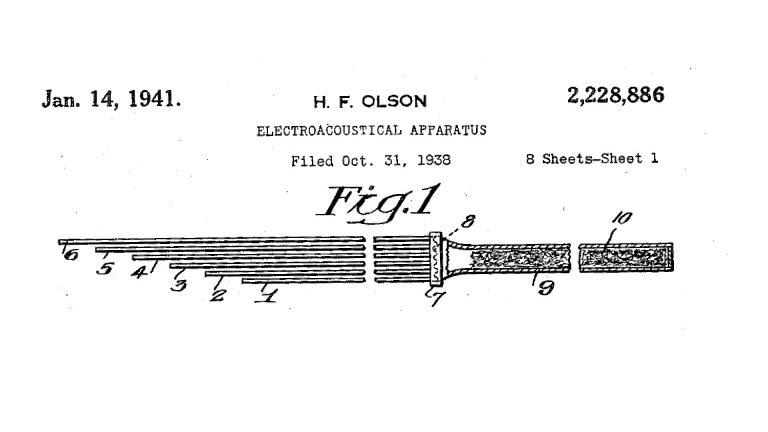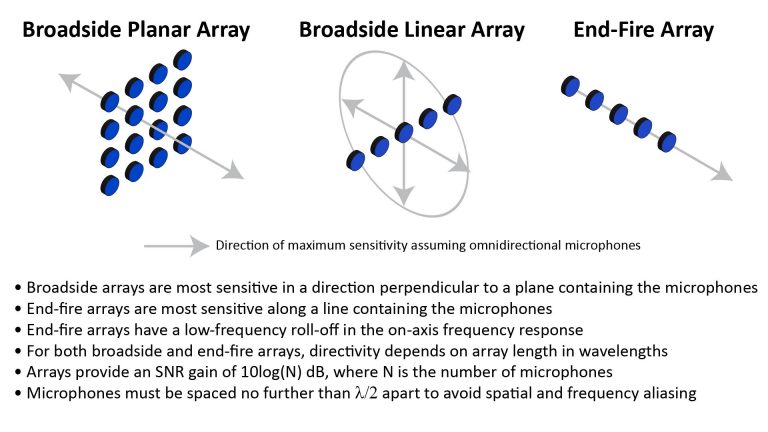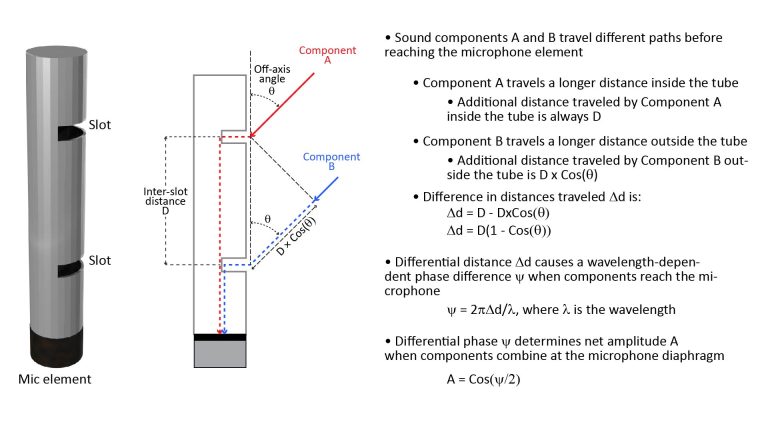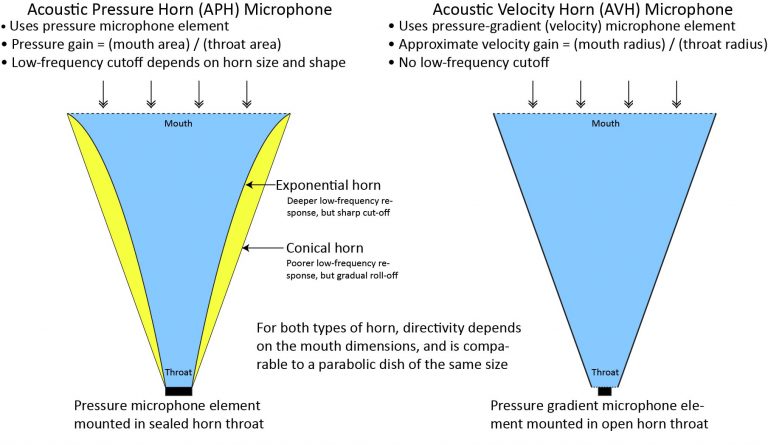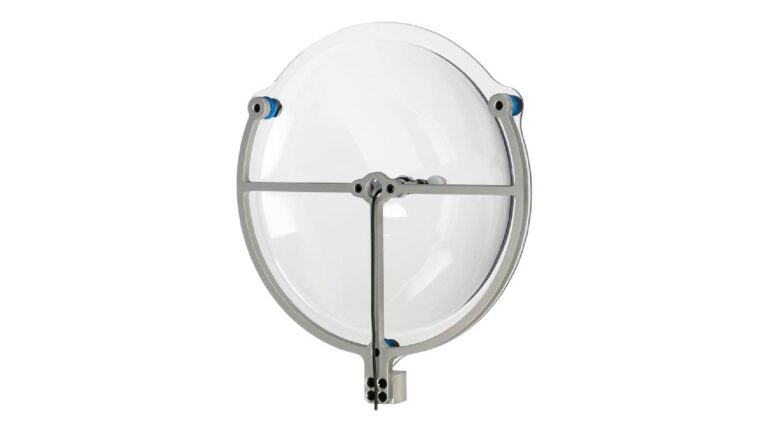If you’ve looked for long-range listening devices on Amazon or eBay, you’ve no doubt come across a cool-looking small parabolic microphone for just 40 dollars. Often marketed under the Hausbell, Podoy, YaeTek, or other brand names, these devices combine a parabolic reflector, microphone, amplifier, rudimentary recorder, and a telescope in a single housing, and even come with headphones. These would obviously make a great toy, but do they really work?
In this post I’m not going to address the recorder or telescope functions of these devices in any detail. Instead, I’m going to focus on the parabolic microphone function: first I’ll analyze the design, then I’ll comment on how it actually works, and finally discuss the possibility of hacking the device.
- The "Hausbell Listening Device" and similar products
- What kind of range can we expect with such a small dish?
- First impressions
- It actually works…sort of
- The all-important reflector
- Can the device be hacked to make it more useful?
- Final thoughts
The “Hausbell Listening Device” and similar products
Amazon and eBay carry several seemingly identical products for about 40 dollars that look like this:
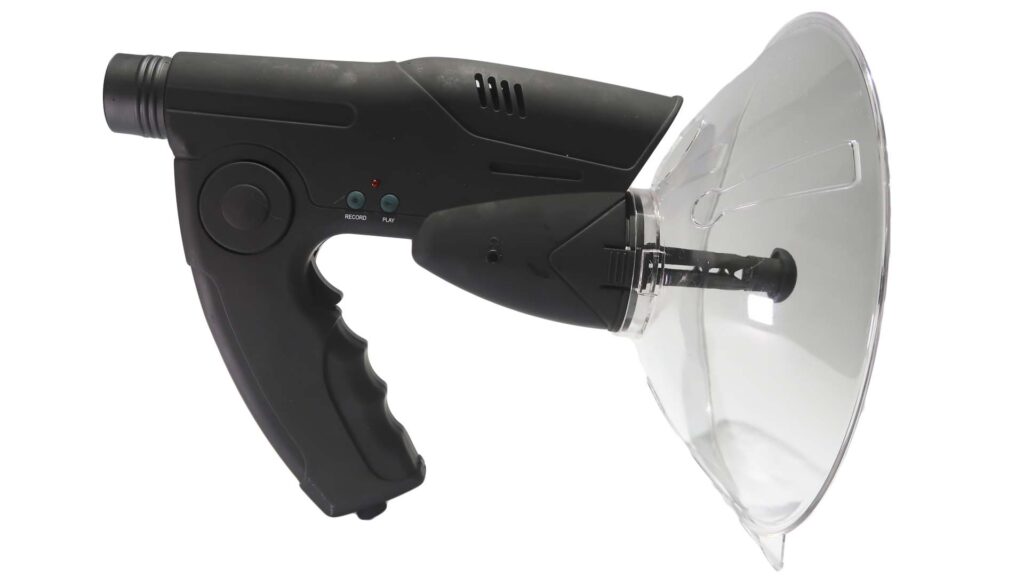
This is photo is of a device sold on Amazon as the “Hausbell listening device,” but the same product is also widely distributed under the Podoy, YaeTek, and possibly other brand names. In addition to a small parabolic microphone, these products include a telescope and a very rudimentary recorder (which, in the Hausbell device I ordered, can only capture 12 seconds worth of sound), and come with over-the-ear headphones.
There is also a similar-looking upgraded product, sold under the HHUK brand (and possibly others) for 60 dollars. This has an upgraded recorder that can record 4 hours’ worth of sound to a memory card and export sound files via a USB stick. This upgraded version also comes with earbuds instead of over-the-hear headphones.
What kind of range can we expect with such a small dish?
Of the various brands of these products on Amazon, Hausbell is the most conservative when it comes to performance claims: it says only that the device is “ideal for kids” and doesn’t make any range claims. The ads for other brands claim a range of up to 100 meters (330 feet) when capturing the sounds of birds. As far as I know, none of the ads (on Amazon, at least) make any claims about ranges against human voice.
However, distributors’ range claims for parabolic microphones are usually based on a combination of extremely optimistic assumptions that would virtually never occur in real life, and therefore shouldn’t be taken seriously. In particular, a claim of 100 meters for such a small parabolic microphone is outrageouly optimistic.
Realistic range expectations
The maximum range of a parabolic microphone is determined mostly by the size of the reflector. All of these devices appear to use the same 7.9-inch diameter reflector, which is only about a third of the size of the reflectors used in typical “real” parabolic microphones.
The gain and directivity of a parabolic reflector vary with the square of its diameter, while the loss in sound pressure level varies with the square of the distance to the source. The net result is that the range of a parabolic microphone is proportional to the diameter of the reflector. Thus, we would expect an 8-inch dish to have only about a third of the range of a 24-inch dish.
So, what kind of range can we realistically expect from small parabolic microphone with an 8-inch reflector?
When used with a microphone element with low self-noise, an 8-inch parabolic reflector can provide a range of the order of 10 feet under typical conditions while picking-up human voice with a Signal-to-Interference-plus-Noise Ratio (SINR) high enough for general recording purposes. In fact, I have a post showing that a parabolic microphone using a high-quality 8-inch reflector (either the MiK 09 or the Sound Shark, both by Klover Products, Inc.) can easily out-perform a full-sized 1000-dollar shotgun microphone (the Shure VP89L).
So a reflector this size can indeed provide a useful level of performance. However, the aforementioned Klover reflectors cost more than 200 dollars each, whereas replacement reflectors for the Hausbell and similar products are available on Amazon (and perhaps elsewhere) for just 10 dollars.
And that’s why this small parabolic microphone caught my eye. I’m always on the lookout for cost-effective parabolic dishes for my microphone projects, so I wanted to know if the reflector was just decorative, or if the manufacturer actually took the trouble to mold it with a true parabolic shape.
As I discuss in my post on how parabolic microphones work, a parabolic reflector amplifies sound by collecting and concentrating it a single point where it can be picked-up by a microphone element. But if the shape isn’t truly parabolic (or more precisely, if it isn’t a true paraboloid of revolution), then there isn’t a single distinct focal point and the directivity and gain are sharply reduced.
I can easily imagine the manufacturer of this device thinking, “this is just a toy, so the reflector doesn’t actually have to do anything. If we use a sensitive mic and enough amplification, kids won’t notice the lack of directivity or acoustic gain. So let’s not even bother to use a parabolic mold.“
On the other hand, a true parabolic reflector doesn’t cost any more than a non-parabolic reflector of the same size. Since the manufacturer had to pick a shape for the mold anyway, why not use a true parabolic mold? That’s what I was thinking, and hoping, when I picked-up a Hausbell unit for evaluation.
First impressions
The Hausbell listening device I ordered off Amazon came in a surprisingly small box, which is possible because it’s shipped with the reflector detached from the device’s main body (fortunately, the reflector just snaps on without tools, which takes just a few seconds):
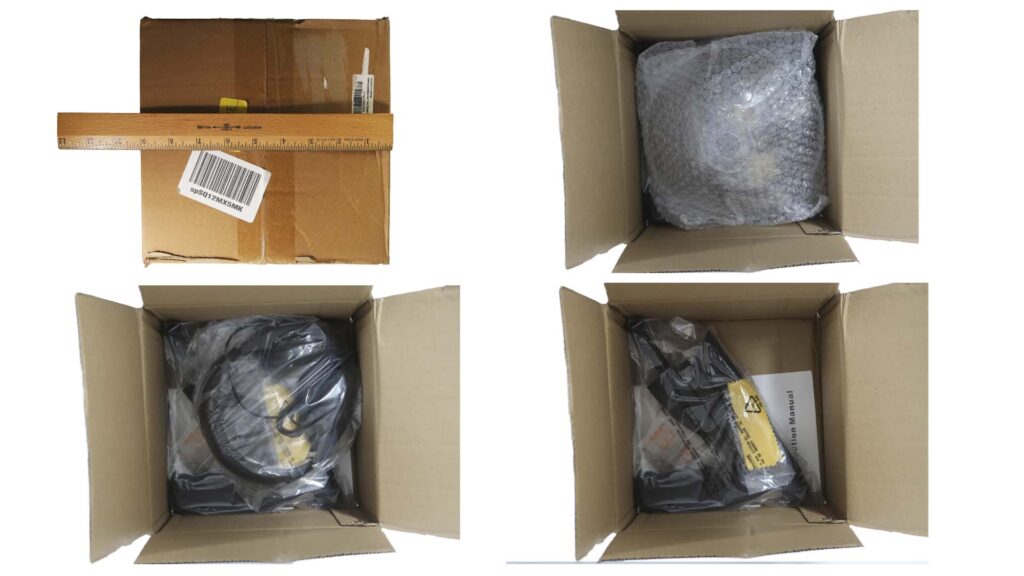
The quality of construction (including the headphones) is a little better than I expected for a 40-dollar toy. It’s actually a very well-designed device, and the supplied 3-page instruction manual was well-illustrated and written in understandable English.
However, three issues were immediately apparent:
- The volume control knob was stuck in the halfway position (and a stuck volume control is apparently a frequent problem according to online reviews).
- Installation of the 9V battery (not included) is a bit of a pain, and could have been a lot easier if the battery leads were slightly longer and the battery compartment opening were a bit bigger.
- The device is turned on by pulling a trigger, and the trigger must be continually held in the pulled position while the device is in use. This is inconvenient, but it does eliminate the risk of accidentally leaving the unit on and killing the battery, which I suppose is a great feature in a kid’s toy.
It actually works…sort of
With the battery inserted, the reflector attached, and the headphones plugged-in and on my head, I pointed the reflector at a television ten feet away and pulled the trigger. It worked!
Unfortunately, it didn’t work well.
The amplifier has a lot of gain, so sounds do seem louder when heard through the Hausbell’s headphones than with the naked ear. A lot of positive reviews compliment the device on this high sensitivity.
However, high amplifier gain is useless in a device of this type unless the amplifier and (even more importantly) the microphone element have low self-noise.
The Hausbell uses an Electret Condenser Microphone (ECM) element. ECMs with relatively low self-noise are available, but it’s apparently an inexpensive element with a relatively high self-noise. And, while I haven’t yet taken the device apart, it appears that the amplifier IC isn’t a low-noise device, either.
The result is that, while sounds are louder through the Hausbell than with the naked ear, they’re also a lot noisier. And what matters is the signal-to-noise ratio, not the sensitivity.
So, without the parabolic reflector, the Hausbell’s high self-noise gives it a much shorter pick-up range than the unaided ear. To be fair, even low-noise microphones and amplifiers can’t match the unaided ear (assuming no hearing impairment), but at least they can get a lot closer than the Hausbell’s noisy electronics.
Fortunately, the Hausbell does have a parabolic reflector, which is why I was interested in the device in the first place. So, does the reflector make up for the noisy electronics?
Unfortunately, no…at least not for human voice. The directivity and gain of a parabolic reflector are proportional to frequency, and there isn’t enough directivity and gain at voice frequencies to make up for the noisy electronics. I could understand voice from the TV from further away with my unaided ear than with the Hausbell.
But how about the performance when picking-up higher-frequency sounds, like the bird songs mentioned in the marketing copy for these devices?
I could hear a 4 kHz tone with the Hausbell from further away than with my unaided ear, and at 6 kHz the difference was pretty dramatic. At those frequencies, the reflector more than makes-up for the deficiencies of the electronics.
The songs of larger birds have most of their acoustic power at frequencies lower than 4 kHz, but there are harmonics that reach even higher frequencies, and smaller birds can produce substantial acoustic power at up to 10 kHz. So, it’s not surprising that with the Hausbell, I was able to pick-up some bird songs from further away than I could hear them with my unaided ear. Still, the range for reasonably good sound quality was far less than the 330 feet quoted in some ads. I was able to clearly hear some bird songs at only 30 feet or so, while others could be picked-up at about 75 feet…but I couldn’t clearly hear anything further away than that.
I’m not a birder, but I don’t think the range difference between the Hausbell and the unaided ear is dramatic enough to justify taking it on a serious bird-watching trip…especially because there are a couple of other issues:
- The telescope offers an appropriate level of magnification (8x), but the objective lens is very small (about 25 mm or 1-inch) and has poor light-gathering power. And my unit wouldn’t focus any closer than 40 feet.
- Because of the noisy electronics, the quality of the bird songs recorded by the device isn’t great. That, coupled with the short (12-second) recording capacity of the Hausbell, makes the recording function fairly useless.
But I didn’t buy the Hausbell for its functionality or performance; I bought it to evaluate its parabolic reflector for potential DIY applications. So let’s shift our focus to the all-important reflector.
The all-important reflector
The Hausbell’s reflector or “dish” appears to be of acrylic plastic of about 2 mm thickness and 20 cm (7.87 inches) in diameter, with three stiffening gussets and a hole to provide a clear field-of-view for the telescope:

Acrylic plastic is very brittle, and an acrylic dish of this thickness is bound to be fragile. So it’s not surprising that many online reviewers have experienced shattered dishes.
But is it truly parabolic?
As I outline in my post on how parabolic microphones work, there are a few ways to determine if a reflector that appears to be parabolic truly is parabolic:
- the “math method” (which involves making measurements of the dish);
- the “flashlight method” (which works only if the dish has a perfectly smooth reflective surface);
- the “microphone on a stick method” (which requires a bit of test equipment); and
- the “frequency-response method” (which requires a bit more test equipment but offers the best accuracy.
Let’s apply the math method to the Hausbell’s dish.
The math method: making measurements to see if the dish is parabolic
In general, the math method involves making several measurements of the diameter-versus-depth of the interior surface of a dish to see if they’re consistent with the equation of a parabola. This process is prone to error if you don’t use some kind of measurement fixture, but can be useful to quickly identify dishes that are distinctly non-parabolic.
Fortunately, since the Hausbell is sold as a fully assembled “parabolic” microphone, we can use a much easier variation of the math method as a quick check: we can determine what the focal length of the dish would be if it were truly parabolic from just its diameter and depth, and then compare that focal length with the actual distance between the microphone and the vertex of the dish. If the microphone isn’t positioned at the dish’s ostensible focal point, that’s a sure give-away that the dish isn’t parabolic. After all, why would the manufacturer go through the trouble of making a truly parabolic reflector and then put the microphone in the wrong position?
Of course, a microphone located at the expected focal point doesn’t prove that the dish is parabolic, but it’s certainly a good sign. If the reflector passes this test, we can proceed to a more definitive test.
The Hausbell reflector’s apparent focal length
The distance from a parabola’s vertex to its focus is given by the following equation:
- f = (D/16d)2 where D is the dish diameter and d is the dish depth.
The Hausbell’s dish has a diameter of 20 cm (7.87 inches) and an interior depth of 6 cm, implying a focal length of 4.2 cm using the equation above.
The Hausbell’s microphone location
Some clearly fake parabolic microphones use a forward-facing microphone element mounted at the vertex of the dish, presumably because it simplifies construction.
The dish in such a configuration actually does provide some gain and directivity (regardless of its shape), but the gain and directivity are far less than in a true parabolic microphone.
Fortunately, the Hausbell is constructed the way a parabolic microphone should be constructed, with a backward facing Electret Condenser Microphone (ECM) capsule mounted at a distance from the dish’s vertex:
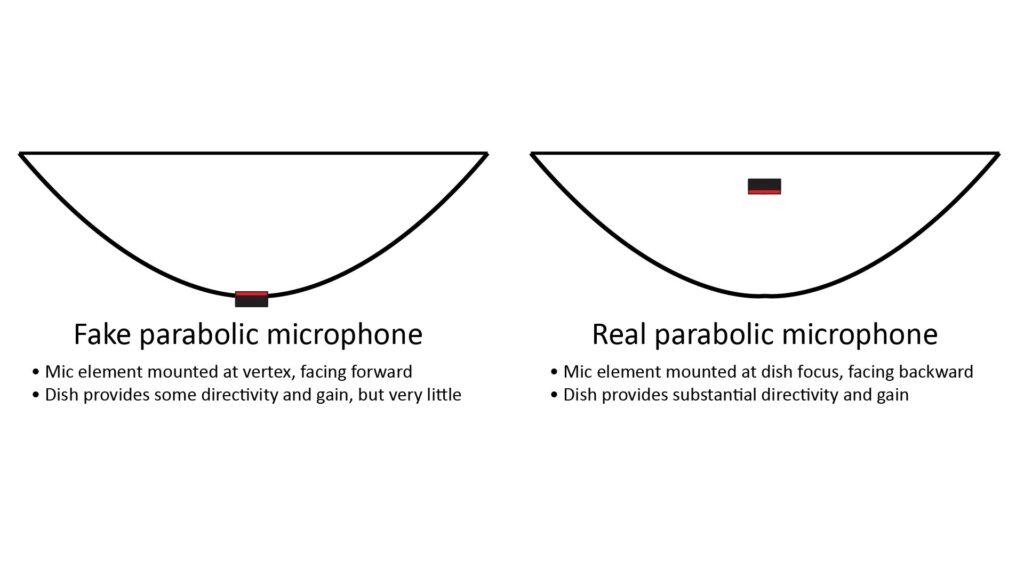
So that’s a good sign that this is a true parabolic microphone. But how does the microphone location compare to the calculated focal length of the dish?
The following figure shows the microphone mounting stalk of the Hausbell device (with the reflector removed). The microphone element isn’t visible, but its location is shown by the dotted line:
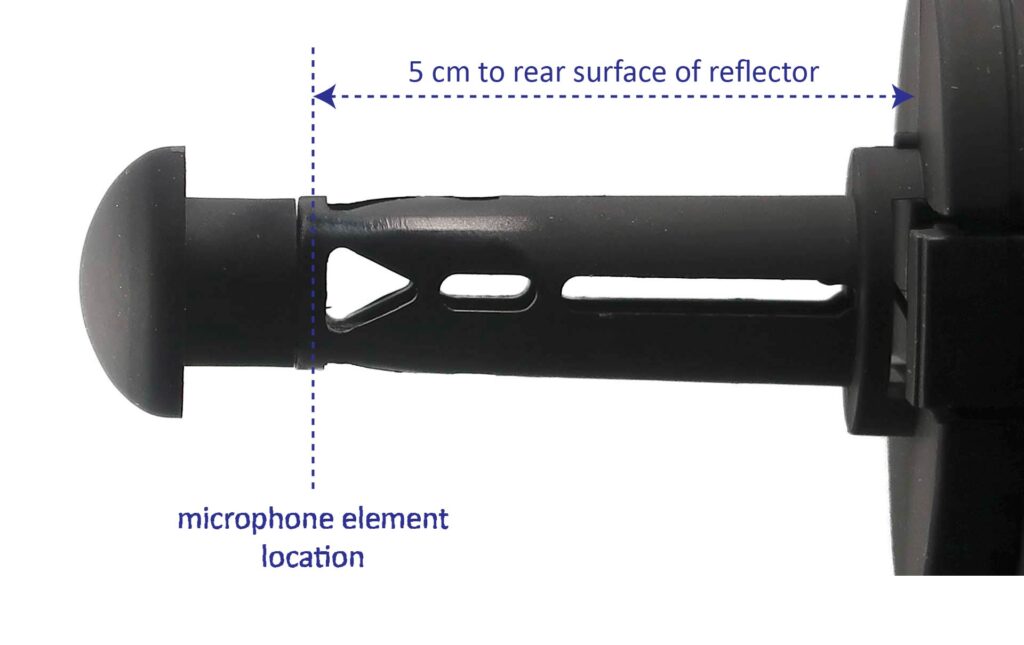
The microphone diaphragm is located 5 cm from where the rear surface of the dish would be located. The dish thickness is about 2 mm, which means that the microphone is positioned at 4.8 cm from the inner surface at the dish’s vertex. That’s not exactly the same as the calculated focal length of 4.2 cm…but is pretty close.
What counts in acoustics is the error in wavelengths, not in units of physical length. In this case, the error of 0.6 cm represents only about a tenth of a wavelength at the upper edge of the voice bandwidth (about 6 kHz). That’s not great, but it shouldn’t dramatically reduce the dish’s performance, especially in the heart of the voice bandwidth (around 2 kHz).
By the way, the microphone stalk, as shown in Figure 5, has what I consider to be a pretty significant design issue. The stalk is effectively a tube with triangular cut-outs to let the sound reach the microphone, but enough of the tube remains to block some high-frequency sound.
The verdict: the Hausbell reflector passes the math test
The fact that the Hausbell’s microphone diaphragm is reasonably close to the calculated focal point is pretty good circumstantial evidence that the dish is truly parabolic.
A more definitive test: does the reflector seem to be doing what it’s supposed to do?
Definitive proof that a reflector is truly parabolic generally requires one of the other tests mentioned above. However, since the Hausbell is a complete parabolic microphone, we have another, much easier option: we can see if the reflector seems to be doing what it’s supposed to do.
One obvious test is to determine the maximum range when picking-up a particular sound, and then compare that maximum range to the expected range for a dish this size. However, there are so many variables that determine the actual range of a parabolic microphone (including the ambient noise level and the self-noise of the microphone element) that a maximum-range test isn’t very definitive. That’s one reason why online reviews of the Hausbell and similar products cite widely varying maximum ranges.
Beamwidth is an easier-to-measure indicator of reflector performance
A byproduct of the gain and directivity provided by a parabolic reflector is a narrow beamwidth: the greater the gain and directivity, the narrower the beamwidth, and the more accurately the dish must be pointed toward the source of the sound. In fact, for a larger dish, the beamwidth can be so narrow at high frequencies that accurate aiming becomes a problem.
Beamwidth is usually quantified as the angular width of the beam over which the sensitivity is within some fraction, usually -3 dB (one-half), of the peak sensitivity. We can estimate the beamwidth of a parabolic reflector as follows:
(Beamwidth equation. Two forms (one with lambda, one with F)??
Here’s a plot of the -3dB beamwidth versus frequency for an 8-inch dish:

A change of 3 dB is barely noticeable by the human ear. Thus, a parabolic microphone must be pointed to within plus or minus one-half the beamwidth of the source, in both the horizontal and vertical planes, to keep the output from falling-off noticeably.
So, suppose we have a speaker emitting a 6 kHz tone. The predicted beamwidth of an 8-inch parabolic reflector at 6 kHz is 20 degrees, so the reflector must be pointed to within 10 degrees of that speaker on either side to keep the output from falling-off noticeably. If the output does fall-off noticeably when the dish is aimed more 10 degrees off-axis, that’s definitive proof that the dish is truly parabolic. On the other hand, if the output doesn’t drop-off noticeably until it’s aimed much further off-axis, then the dish is not perfectly parabolic (or the microphone isn’t accurately positioned at the dish’s focal point).
The only equipment needed for such a test is a smartphone and a free sound-generator app. Just set the app for the desired frequency, put the phone on a table, step back ten or twenty feet, point the dish at the phone, and vary the aim while listening to the output. The object is to get a rough estimate of the angular range of the dish’s pointing angle over which output seems relatively constant. If that angular range is close to the predicted beamwidth for that frequency, the microphone is working as it should and the dish is parabolic. There’s no need to use a protractor or other tools for such a test; a subjective estimate of the angular range is accurate enough to determine if the dish is parabolic.
The verdict: the Hausbell passes the beamwidth test, too
Using the test described above, I found that the Hausbell device’s apparent beamwidth is, indeed, about what would be expected of an 8-inch reflector with a truly parabolic shape. It was obvious, even without making any measurements, that the dish was performing as it should.
Can the device be hacked to make it more useful?
So the Hausbell doesn’t work well enough for serious applications, but it does have a true parabolic reflector. And, as documented in my post on the Klover MiK 09, a reflector this size can support a useful level of performance when coupled with the right microphone element and electronics.
So, are there opportunities to hack the Hausbell to leverage the full potential of the reflector? Yes, but not all of them make sense.
Using the replacement reflector to build a small parabolic microphone
From a DIY perspective, the best thing about the Hausbell is the parabolic reflector…and the best thing about the reflector (other than the fact that it’s truly parabolic) is that it’s available separately for about ten dollars. So, in a way, it’s fortunate that the reflector is so fragile, because it probably wouldn’t be available separately if it didn’t break so frequently.
Building a DIY parabolic mic using a replacement Hausbell reflector is the subject of another upcoming post, but here are some pics of one to whet your appetite:
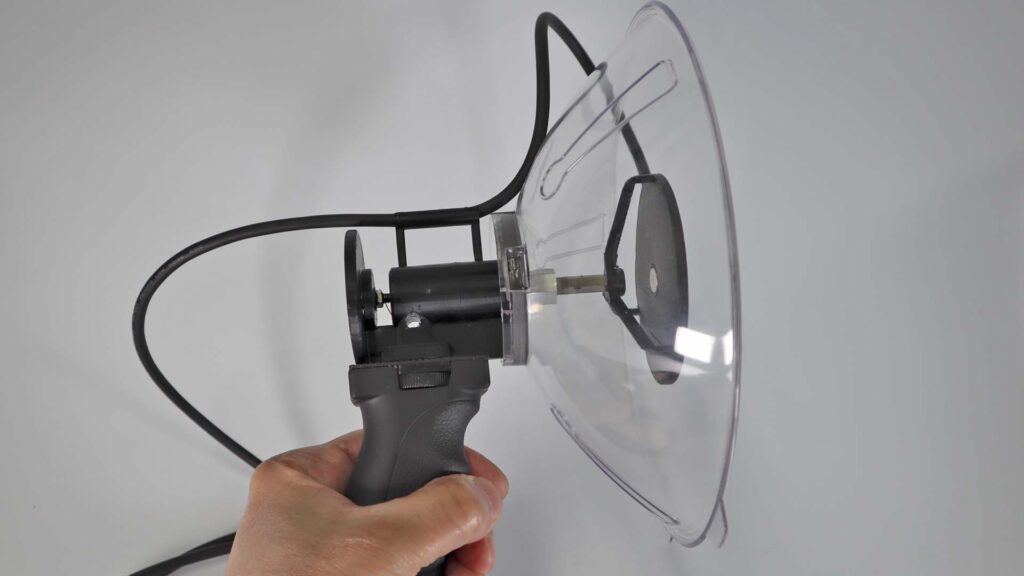
In addition to a replacement Hausbell reflector, this DIY parabolic mic uses a 3D-printed base (including a threaded focusing mechanism and a 1/4-20 tripod socket, into which a pistol-grip has been inserted) and a high-quality, low-noise ECM element, and works quite well as an alternative to an expensive shotgun microphone. By the way if you want to know the purpose of the disc that holds the microphone element, check out the shielding disc section of my post on how parabolic microphones work.
I’m also finishing-up another version of a parabolic microphone using the Hausbell replacement reflector that’s lighter and simpler, and can be mounted directly on a DSLR or mirrorless camera (like the Klover MiK 09). Stay tuned!
Upgrading the whole device
The housing of the Hausbell and similar devices is stylish and already includes the structure necessary to mount the microphone and dish. So why not upgrade the complete unit, rather than starting from scratch with a replacement reflector?
One reason is that the complete device costs about 40 dollars, while the replacement reflector is only 10 dollars.
Another is that the housing is much larger and heavier than it needs to be. The heart of a parabolic microphone is the parabolic reflector, so the reflector should account for most of the size and weight of the overall microphone, and that’s not the case with the Hausbell. This is partly because of the telescope, which is useless for serious applications for such a small reflector (except possibly for bird-watching), since the achievable pick-up range is so short.
However, if you already have a complete device in your possession and are interested in improving its performance for bird-watching (and if you find the telescope useful), then there are few ways the device could be improved. I’ll explore these further in an upcoming post, but the following paragraphs provide an overview of some of the modifications I’m investigating.
Replacing the Hausbell’s microphone with a higher-quality ECM element
A weak link in the Hausbell’s design is the ECM microphone element, so an obvious hack to consider would be replacing the element with a better one positioned at the exact focal point of the dish (which isn’t the case with the stock unit). This would also require changing the bias resistor in the Hausbell amplifier to ensure the correct bias voltage and load resistance for the new element.
This should be a relatively straightforward mod, although it appears that getting access to the existing microphone element would require separating a glue joint, which could be a little tricky.
Replacing the Hausbell’s electronics
If the Hausbell’s microphone element is replaced with a better one, then the next level of modification to consider would be replacing the stock PCB with one using upgraded electronics. Potential improvements include a lower-noise amplifier chip, the addition of a switchable 6 dB-per-octave equalizer, and elimination of the trigger switch in favor of a slide or toggle switch. Such mods would entail getting rid of the recorder, which is pretty useless anyway.
Another potential improvement would be replacing the 9V battery with a rechargeable Li-Ion pack inside the handle.
Adding a tripod mount
If the Hausbell’s performance is improved via the mods described above, then another useful improvement would be add a 1/4-20 socket for mounting on a tripod. The best way to do this is to use a 3D-printed base to accept a press-fit 1/4-20 threaded insert, which can then be epoxied to the Hausbell’s housing.
Final thoughts
Summing up, the Hausbell Listening Device (and similar products) do work in the sense that they are true parabolic microphones: the reflector has a true parabolic shape, and the microphone element is mounted close enough to the focal point to get the benefit of the reflector’s directivity and gain.
However, the device has too much self-noise for serious applications, and while it can extend the range at which high-frequency bird songs can be picked-up, that range is closer to 33 feet than the claimed 330 feet if you want to hear the songs with good clarity.
Still, as the DIYmics guy, I consider all of this to be great news because it means that we now have a source of a small, truly parabolic reflector that can be used in all kinds of DIY projects. Stay tuned!

